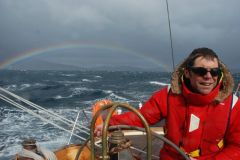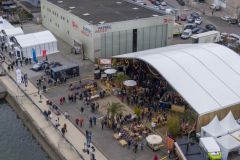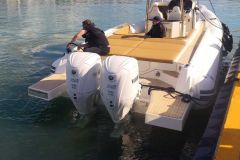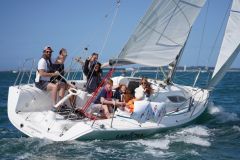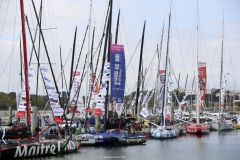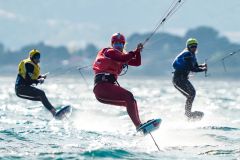An observation: too much ocean pollution
It was during his numerous oceanic navigations that the adventurous sailor Yvan Bourgnon was confronted with pollution. Notably during the Transat Jacques Vabre, which he raced with skipper Gilles Lamiré, on board the Multi 50 La French-Tech Saint-Malo . The two sailors had collided with a container, seriously damaging both floats, which forced them to abandon the race. But also during his Around the world in a sport catamaran yvan was able to hit many floating objects (UFO for Unidentified Floating Objects).

The navigator has therefore decided to launch the association "The Sea Cleaner" dedicated to ocean pollution . He is also embarking on the construction of a plastic waste collection vessel, the Manta. To support his project, Yvan launched a crowdfunding campaign, started on October 14, 2016.
"Between 8 and 10 million tons of plastic are dumped into the oceans each year. Some of this floating macro-waste breaks up on contact with the waves and UV rays and is transformed into micro-waste and then into nano-waste, which is assimilated directly by marine organisms, impacting the entire marine food chain. By 2025, the amount of plastic waste entering the marine environment could be multiplied by 10. At this rate, in 2050, the pieces of plastic present in the oceans will be as numerous as fish! explains the navigator.
Today, 60% of plastic waste is dumped by only 3% of coastal populations. The biggest polluters are in Asia, led by China with 8.8 million tons of plastic waste mismanaged in 2010. Then come Indonesia (3.2 million), the Philippines (1.9 million), Vietnam (1.8 million) and Sri Lanka (1.6 million).

This waste concentrates very quickly in certain areas, according to the currents and natural disasters. It is therefore necessary to collect as close to the source as possible, before this waste disperses, reduces and ends up on the ocean floor.
A boat capable of recovering waste as close as possible
Yvan Bourgnon and his âeuros team composed of Patrick Fabre (Founder of the NGO OCEANOPLASTIC) and JérÃ'me Vollet (Designer and naval engineer âeuros CEO of ESY CONCEPT) âeuros have therefore decided to launch through the association a boat that can offer the necessary mobility to go as close as possible to the spills.

The Manta âeuros, which owes its name to the Manta ray and its ability to filter water âeuros has been designed to collect waste as close as possible to the sources of spillage, near the coasts. This four-hulled ship (4 hulls) offers the necessary mobility to move quickly to the plastic banks concentrated by the currents and winds before they move into the oceans and join the plastic continents. But it can also move to the high seas, where anchoring is made impossible by the ocean depth, and absorb the waste that may have been released by containers, at the surface and up to 1.5 m deep.

The propulsion of the multihull will be provided by a Kite Wing (kite) combined with a rigging system supporting conventional sails, plus a hybrid propulsion unit. This will allow to reduce the carbon footprint to a minimum.
Collecting waste with a ramp system
A 72 m wide collection ramp will allow the collection of macro-waste without harming the aquatic fauna. Indeed, the vessel will be equipped with an electronic sound emission device to keep away the marine fauna when approaching the vessel and avoid accidental fishing. The collector will be able to collect both plastic waste larger than 1 cm2, but also drifting fishing nets, the Ghostnets.

Inspired by whale baleen, this biomimetic system will fold up to pass through canals (like Panama) and port entrances.
A network of conveyor belts will transport the macro-waste to the storage tanks, which can hold 300 m3 of plastics. The collection campaigns will last from a few days to several weeks. In total, the boat will have an autonomy of 2 months.

A 2-month fundraising event
On October 14, 2016, Yvan Bourgnon launched a crowdfunding campaign that will last until December 13. The goal is to recover 80,000 euros, the sum needed to launch the association "The Sea Cleaners." On October 21, already 23% of the total goal has been collected, or 18,622 euros, brought by 310 donors!
As a reward, the donors will be able to meet the navigator, who will show them the plans of the boat. They will be able to discuss the progress of the project together or even go on a sea trip aboard "Ma Louloute", the sports catamaran on which Yvan Bourgnon sailed around the world between 2013 and 2015.
Finally, the biggest reward will be a trip to Alaska next June to attend a week of final preparations for the yvan's next challenge the attempt of the first single-handed North-West passage under sail on a boat without cabin.

"The first studies were self-financed. The project is now viable and recognized by all as a real trigger for concrete actions in the field. We now need to launch the project on the rails that will take it to the water to clean the oceans. Your participation in this campaign will allow us to launch the detailed studies and tests in a tank and then in a real situation, and to launch the construction of the first Manta.
This project is yours, together we will participate concretely in the reduction of ocean plastic pollution. We are a team, I bring you my experience and I suggest, if you are sensitive to this subject, to bring us your financial contribution in order to launch this great intergenerational challenge" details the navigator.

